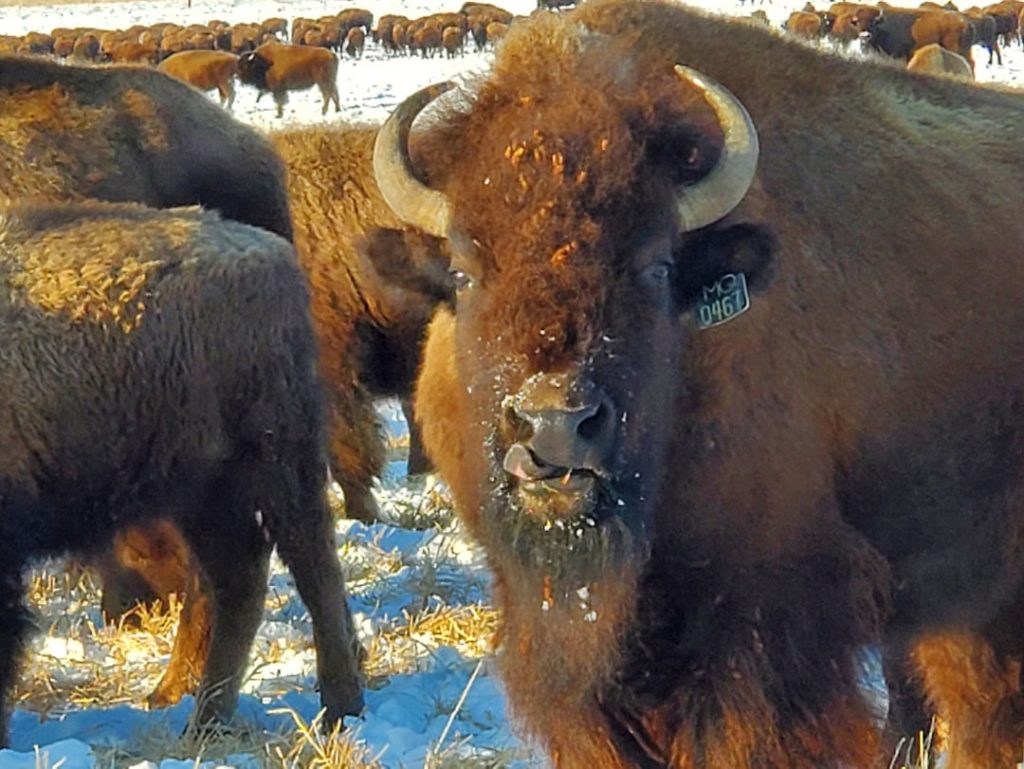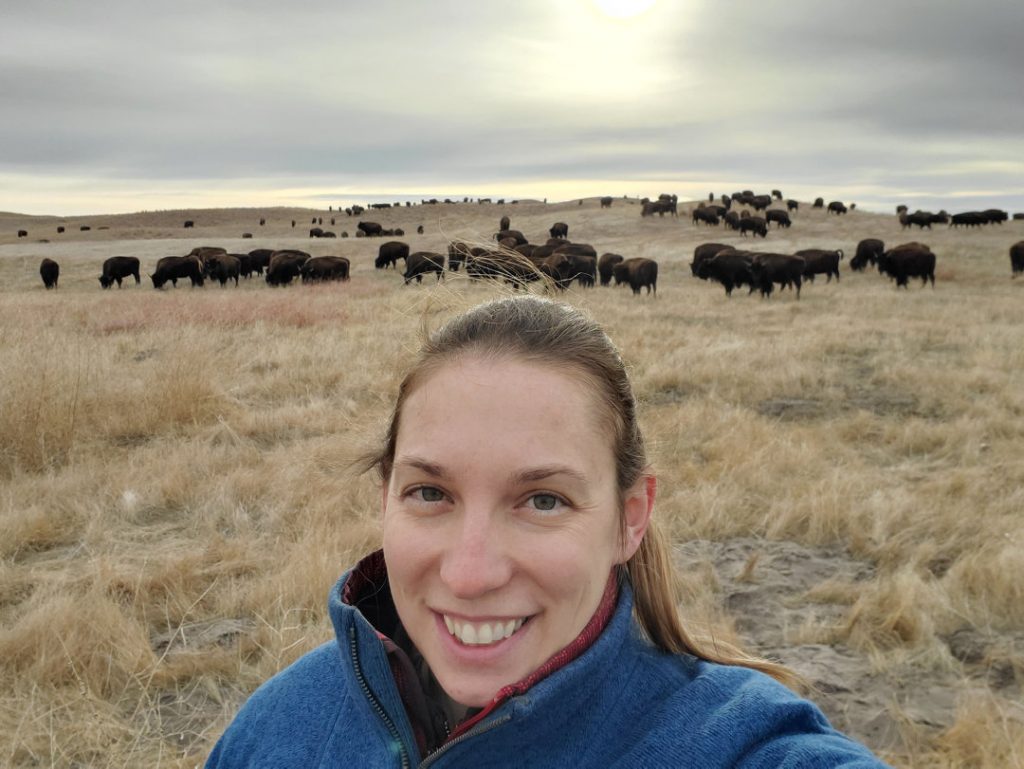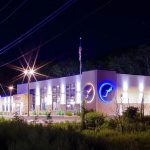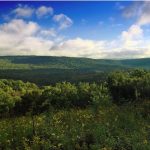Gaimi Davies found a home where the buffalo roam.
And thanks to the work she does on a Nebraska ranch, those majestic, all-American animals will continue to thrive in the wide open spaces of the West.
Davies didn’t set out for the cowgirl lifestyle while growing up in Northeast Pennsylvania, but she’s loved animals since she was little. Her earliest memory is of pulling herself across the floor to pet her family’s cat, but when Davies graduated from Wallenpaupack Area High School in 2002, she wasn’t sure how to turn her interest in animals and science into a career.
“I didn’t really have any clear vision for my future,” Davies, 36, said by email this month.
She decided to pursue a double major in biology and environmental science with a concentration in terrestrial conservation and a minor in statistics at University of North Carolina Wilmington. She worked as a horse farm manager while still a student, and once she had her degree, she started looking for scientific jobs, eventually picking up some chemistry lab positions.
Davies found her true calling, though, while working as a summer keeper at Claws ‘N’ Paws Wild Animal Park in Wayne County, where she’d go during the day before heading to her cocktail waitressing gig at Cove Haven Resort at night. It marked the first time she’d seen a bison up close, and she soon fell in love with the animals.
The zoo had a bison bull named Larry that Davies said kept her in awe from the beginning.
“I was exposed to a lot of amazing and exotic animals there but I was drawn to the bison because of the way he carried himself,” she said. “There was something about him that I found very calming, and when I looked in his eyes, it felt like there was so much behind them.”
Davies took things slow with Larry, who didn’t interact with her at first. Over time, he began coming closer to her at the fence.
“Eventually he would come over to greet me, and I could climb up onto the fence, reach over and give him a good scratching,” she recalled. “Sometimes he would close his eyes and let me pet his face, ears and horns. That felt like a very special gift because I knew he trusted me.”
Her time at the zoo taught her a lot about bison but also about “the history surrounding their near extirpation and the challenges we face in conserving them,” Davies said. The National Bison Association estimates that 30 million to 60 million bison made up the North American herd before 1600 and the destruction that came with subsequent European settlement; today, they number just over 362,400.
With a career in bison conservation in mind, Davies went back to school, this time at University of North Dakota, where she focused her thesis for her master’s degree in biology on bison. She worked on a bison paleoecology project with a geneticist, Dr. Igor Ovchinnikov, who had been one of the first people to sequence Neanderthal DNA.
“I pursued the educational path that I did because it seemed like the best way for me to make a difference in bison conservation,” Davies said.
Today, Davies works as a ranch technician on an 80,000-acre ranch owned by Ted Turner in the Sandhills of Nebraska, where the closest town, Gordon — where she lives with her husband, Steven — is 40 minutes away. Davies is one of four full-time employees managing 4,000 bison in three herds. Her job mainly involves managing the “flex” herd, which she said “consists mostly of yearlings but has some older babysitter cows mixed in for the first half of the year.”
“We call it the flex herd because our management plans for them remain flexible based on drought conditions and how much forage we have growing,” Davies said. “I move them through pastures according to our grazing plan, maintain pastures fences to keep them intact and electrified, and maintain water sources which we run on renewable energy (solar and windmill).”

SUBMITTED PHOTO
The ranches practice regenerative agriculture — “farming in a way that allows us to nourish the land and soil rather than just take from it,” she said.
She also keeps track of the research projects the ranch conducts with other entities, some of which helps it improve its best practices. And Davies serves as the safety chairwoman for Turner’s Western properties, which involves handling her ranch’s safety education and protocols and staying in touch with the other ranches regarding safety concerns and improvements.
And Davies must look out for the health and safety of the herd, too, helping the bison through illnesses and disease outbreaks, even if it’s not always a pleasant task. When they had what she described as a bad mycoplasma outbreak, for instance, their only option to keep the herd healthy was to euthanize the affected bison as soon as they found out they were sick.
“We have preventative measures (vaccines, minimizing stress) and are working to improve mycoplasma protocols with universities and the other vested members of the bison community, but we have no cure right now,” she said.
As she learned more about the way the Turner ranches operate, Davies said she realized their ideals align with her own. The ranches practice regenerative agriculture — “farming in a way that allows us to nourish the land and soil rather than just take from it,” she said.
“It aims to work with biological systems to conserve ecosystem services and achieve a level of biodiversity that was present before we started converting wilderness to farmland on massive scales,” Davies said.
The ranch has protocols that let them “listen to what the land and the bison are telling us in order to best manage the resources we have,” Davies said. She hopes people understand that they want to manage the bison in a way that promotes and conserves biodiversity and to provide healthy meat for as many people as possible.
Bison offer a leaner alternative to beef, with 2.42 grams of fat per 100-gram serving of cooked bison compared to 10.15 grams of fat per 100-gram serving of cooked beef, according to the National Bison Association. It estimates approximately 69,000 bison were harvested in the United States and Canada combined in all of 2020, while 125,000 beef slaughters take place in the United States alone each day.
“Our animals live happy lives, are honored and treated with the most respect for the sacrifice they make to provide us with food,” Davies said. “We employ low-stress handling methods to ensure that we produce bison meat in ethical and sound ways.”
Bison in particular work well in regenerative agriculture, in part because they evolved with the landscape since the Pleistocene epoch “and are considered a keystone species because their presence has a cascading effect on other forms of life,” Davies said.
“Bison hooves are perfectly designed for tilling up soil and pressing seeds into the ground to start the growing process,” she said. “They are natural gardeners.”
And they have cultural reasons to bring bison back to the West, too.
“Native communities are starting to manage bison again and gain sovereignty and are healing through producing a food source that has been so closely tied to their culture for thousands of years,” Davies said.

SUBMITTED PHOTO
Gaimi Davies works as a ranch technician on an 80,000-acre ranch owned by Ted Turner in the Sandhills of Nebraska, where the closest town, Gordon — where she lives with her husband, Steven — is 40 minutes away.
Davies spends a lot of her days quietly riding alone in a side-by-side vehicle with just the bison for company as she tends to them, the land and the ranch’s infrastructure. The animals shape her day and give her an opportunity “to witness all of the beauty that nature offers when you take time to observe it.”
“I love that my day’s plans aren’t only determined by me and my boss,” Davies said. “The bison always have a say in how my day is going to go. We joke on the ranch that we make plans so that we can throw them out the window.”
She loves watching the herds range over the vast landscapes that give her a glimpse of what the region looked like before European settlers arrived and the bison population plummeted. She witnesses the communication that takes place among the animals “on a level that I can’t understand or explain from my human perspective.”
“I consider myself very lucky for being able to work with, take care of, and observe such an amazing and resilient animal every day,” Davies said. “When I am near bison, I feel the most grounded and centered.”
In the coming years, Davies hopes to continue to grow within the company — specifically in its research efforts — and eventually end up in a management position.
“As long as I can contribute to the collective knowledge we are gaining as a regenerative (agriculture and) bison community,” she said, “I will feel like I’m making a difference for future generations.”

Caitlin Heaney West is the content editor for Access NEPA and oversees the Early Access blog in addition to working as a copy editor and staff writer for The Times-Tribune. An award-winning journalist, she is a summa cum laude graduate of Shippensburg University and also earned a master’s degree from Marywood University. Caitlin joined the Times-Shamrock family in 2009 and lives in Scranton. Contact: cwest@timesshamrock.com; 570-348-9100 x5107; or @cheaneywest




